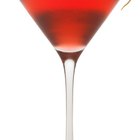
Although the word “vodka” is a diminutive of the Slavic term for “water,” the spirit has emerged from its somewhat brooding Eastern European background, where it was distilled from Russian potatoes, to enjoy a renaissance as a cosmopolitan mixer for stylish cocktails including the vodka martini, screwdriver and bloody Mary. Nowadays, nearly all vodka is distilled from wheat, barley and rye. While it is still infused with herbs in Eastern Europe, vodka sold in the United States must be colorless, odorless and flavorless – easily done, since it is one of the few spirits not aged in wooden casks. Recently, the trend has been towards overproof vodkas in order to put some daylight between otherwise indistinguishable brands.
Proof Basics
The proof of a vodka listed on the label is simply double the percentage alcohol content. Proofing dates back to the British Royal Navy and the 18th century, when gunpowder was tossed into distilled spirits and ignited. A blue flame indicated that the alcohol level was in the optimal level of 114 proof, whereas too little alcohol would fail to light the gunpowder and usually hinted that the spirit had been watered down. Later, the U.S. Federal Government decided that quality spirits be bonded at 100 proof. However, higher proof vodkas, particularly for use in cocktails, retain more flavor and are becoming increasingly fashionable compared to most branded vodkas of around 80 proof.
Top Firewater
Polish-made Spirytus vodka tops the lot at 192 proof and should remain, since the highest possible distillation for an ethanol-water mix is 94.68 percent. A higher ethanol level cannot be achieved by distillation, no matter how many times the vodka is distilled. Rubbing alcohol, by comparison, is 91 percent alcohol. Spirytus is currently the strongest liquor on sale in the U.S., having been approved for sale by the New York State Liquor Authority in 2010, at the behest of the city’s Eastern European community. Rather worryingly, it was a favorite tipple of Siberian pilots, according to legend. Because of its overwhelming strength, the vodka should not be drunk neat, however, but used instead as a “float” in cocktails.
Scottish Export
The Pincer distillery from Glasgow makes a Shanghai Strength Vodka at 177 proof, which the producer emphasizes is not meant to be drunk straight, but used as a mixer. Accordingly, the bottle delivers 65 shots, as opposed to the customary 26, thus reducing packaging and creating what the producers term an environmentally friendly “botanical vodka,” with elements of milk thistle and elderflower. Created for the Chinese export market, the vodka’s 88.8 percent alcohol content is in homage to the number 8’s lucky status in Chinese culture.
Balkan Mixer
Balkan vodka is not sold in the U.S., but it is popular in South America and in 20 other countries, where few bars will serve it without a mixer. The Serbian vodka is 176 proof and is triple distilled, reducing the level of congeners, which add aroma and taste, but concentrating the level of alcohol. The bottle comes with 13 different health warnings, including one in Braille. Despite its fearsome alcohol content, Balkan 176 is clear and flavorless, with a slightly oily texture best enhanced by storing in the freezer.
Related Articles

What Is the Highest Proof Tequila?

Can Drinking Old Vodka Hurt You?

How Long Can a Bottle of Vodka Last ...

Alcohol Content: Proof vs. Percentage ...
What Is the Difference Between 80 & 100 ...

What Can You Mix With Blended Scotch?
How Long Can You Keep an Open Bottle of ...

How Long Does Liquor Keep in Storage?

How to Store Cognac

Can I Substitute Vodka for Rum in a ...

What Liquors Are Made From Sugar Cane?

What Is the Primary Difference Between ...

Do You Need to Refrigerate Homemade ...

Triple Sec & Vodka Drinks

What Is the Difference Between a Shake ...

Can You Substitute Rum for Brandy?
List of Popular After Dinner Drinks

What Is a Good Substitute for ...

Does Brandy Ever Go Bad?

List of the Different Types of Champagne
References
- Travel + Leisure: World’s Strongest Liquors
- Washington Post: Spirits, Understanding Alcohol Proof
- Luxist: World’s Strongest Vodka
- Master of Malt: Balkan Vodka
- The Whiskey Exchange: Spirytus Vodka
- Nuffy: World’s Strongest Alcohols
- Tastings: Vodka
- Online Etymology Dictionary: Vodka
- Drinks Direct: Balkan 176
Resources
Writer Bio
Nick Marshall is a UK-based writer specializing in trends and best-practice in the B2B sector.
Photo Credits
John Foxx/Stockbyte/Getty Images